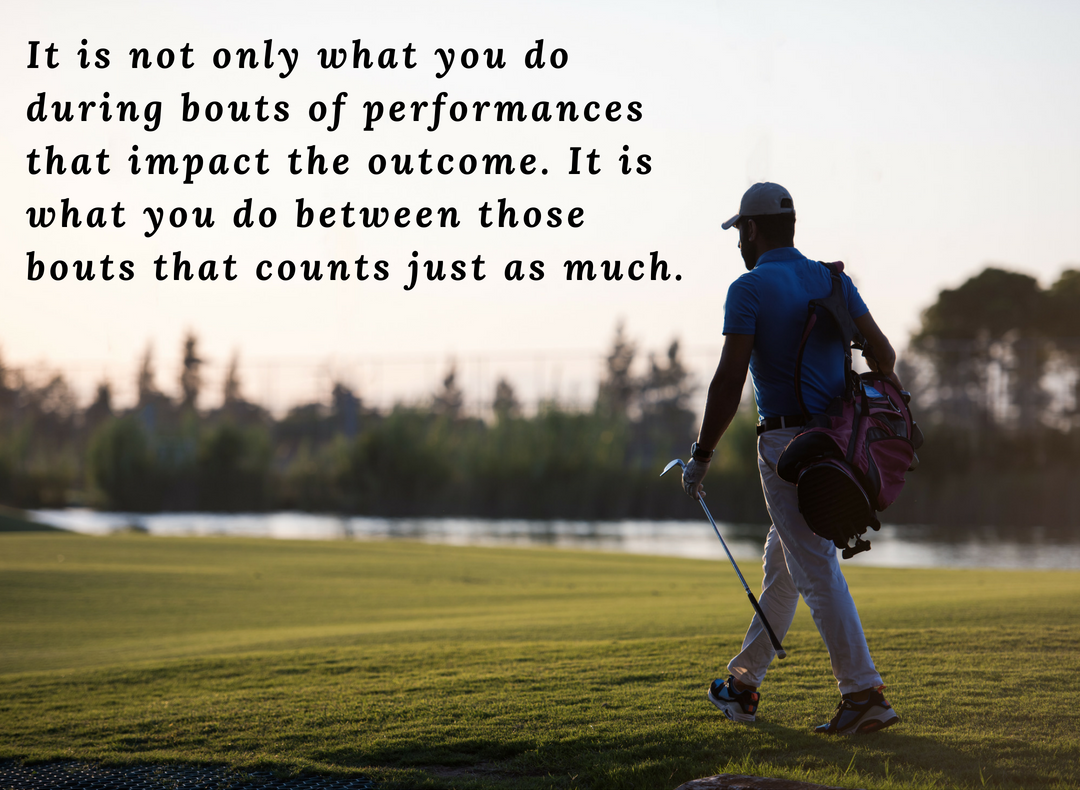Skipping those pesky PRE-performance routines for now, the second performance phase where routines come in play is during or within the overall performance. I prefer to call them intra-performance routines. These take all shapes and sizes and are influenced heavily by the time restraints, sport/task demands, and the individual performer.
But why do we even need these systematic routines in the middle of our match, game, round, etc.? To be honest sometimes we don’t need them and those times are great. That means you are running all cylinders, you have adequate energy and are performing free, automatically, and without hesitation or over-thinking. However, this doesn’t happen all the time and a strategy for optimizing focus, intensity, confidence, and emotions when needed is key.
As mentioned above, you and your sport play a major role in defining the shape of an intra-performance routine. A routine for tennis players could be extremely short between points, but longer between sets. A baseball pitcher may have a routine between every pitch as well as in the dugout between innings. A golfer must perfect these routines as they actionably perform in 70-ish bouts of 2 second intervals in an entire 18-hole round that lasts 4 or so hours! The athlete is the other major factor. Some athletes will not need to plan strategies for managing intensity but will really want to systematically approach self-talk statements to keep confidence high throughout their entire performance. Others may use self-talk statements, but for the main purpose to reserve vital energy required to win later in the match. Additionally, we all have a focus preference that helps us. That focus can be internal (e.g., tuning in to your physiology, rehearsing your performance, talking to yourself, etc.) or it can be external (e.g., talking to teammates and coaches, listening to music, focusing on opponents, etc.) and knowing which is best for youis the key! How you build your intra-performance routines depends on your needs as an athlete-performer.
Similar to the last post about pre-performance routines, you simply build mental and physical strategies that will best prepare you to win the next performance bout. That next pitch, that next service, that next shot. Whatever your performance is you should be fully invested and focused on that small performance interval. Where an intra-performance routine is the most powerful is when you are struggling. If time permits, customize something like this intra-performance routine to help you get back on track:
Step 1: REST.
- Recovery for your body and your mind.
- Sit if you can, or slow down the pace to recover physically. If you are struggling your intensity may be too high and fatigue may be the result.
- Use an arousal regulation technique such as diaphragmatic (i.e., belly) breathing or muscular release techniques to begin to control and recover physiologically.
- Mentally have a reset focus. This includes time and place. In other words, think about the present tense (e.g., the right now), not about the bad shot you just made or how awesome it is going to be when you win the tournament. If you think about your breathing your focus will be present and it will have singular location, taking your attention away from things that could harm your recovery and preparation for the next performance.
Step 2: REVIEW IMAGERY
- Now turn your focus from your breath and recovery to strengths and successes. Image the last time you played your best and relive a moment within that performance. Here, if you are struggling, review the struggle in your mind and decide to make only one change, one adjustment, mentally or physically. You will not succeed trying to change 4 things at once.
Step 3: REGROUP
- Use a productive self-talk statement, either motivational or instructional.
- Image a successful performance in your head.
- Take a breath.
- Then place your focus where it needs to be.
- And let your body perform automatically.
This seems tedious! But your sport may allow this much to happen between bouts of performances. Also, the more you use a routine, the faster you go through it and the more powerful it becomes. Of course, you could only use a portion of this example too. The idea is to build a strategy that best addresses the needs of your mind and body, taking into consideration the constraints your sport places on you.
Really think about what you do BETWEEN performances. Is it as efficient and effective as possible? If it isn’t, try something new. Or better yet, let us help you develop a plan to take you to the next level.
Let it fly!
-Tyler
Let us know what you think:


